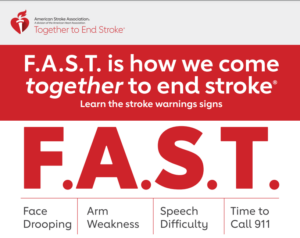Each year, more than 795,000 Americans experience a stroke. While the majority of those strokes are ischemic strokes, there’s another kind of stroke to be aware of, too.
Nearly 90% of all strokes are ischemic strokes, which occur when a blood vessel in the brain is blocked. But strokes can also be caused by a blood vessel that weakens and then bursts in the brain, which is known as a hemorrhagic stroke.
Wondering what else you should know about this other kind of stroke? Read on to get the facts.
What a Stroke Is
You’ve probably heard about strokes, or you may even know someone who has experienced one, but do you truly understand what they are and how they happen?
Every 40 seconds, someone in the United States has a stroke. When a stroke occurs, it damages the brain in some way. That’s why stroke is a leading cause of death among Americans and the leading cause of disability.
The two types of stroke cause brain damage in different ways. When an ischemic stroke (also called an ischemic attack) occurs, a blood clot blocks the blood vessels to the brain. This blockage deprives the brain of oxygen and nutrients, which causes brain cells to die off.
When a hemorrhagic stroke occurs, on the other hand, a blood vessel in the brain ruptures, causing a brain bleed. The excess blood in the brain puts pressure on the brain cells, which damages them.
Beyond these two types of stroke, there’s also a condition called a “mini-stroke,” or a transient ischemic attack. Focus on the word transient in that name.
A mini-stroke is the same thing as an ischemic attack, but it is fleeting, so the blood clot displaces quickly and symptoms resolve within a few minutes. A mini-stroke can be a sign that a regular stroke may occur in the near future.
The Facts About Hemorrhagic Stroke
There are two types of hemorrhagic strokes—intracerebral, which is bleeding inside the brain, and subarachnoid, which is bleeding between the brain and its outer covering.
When a blood vessel in the brain ruptures and bleeds in either space, brain cells in the surrounding area begin to die off. This can cause a number of symptoms, including:
- Sudden confusion
- Sudden difficulty seeing out of one or both eyes
- Sudden difficulty speaking or understanding speech
- Sudden numbness or weakness of the face, arm, or leg, particularly on one side
- Sudden severe headache with no known cause
- Sudden difficulty walking or a loss of balance
You’ll note that each of the symptoms includes the word “sudden” at the beginning. That’s because strokes typically strike fast—and your reaction needs to be just as fast.
When a stroke occurs, immediate treatment is needed to limit brain damage. If a hemorrhagic stroke is suspected, the emergency medical team will first look to determine what’s causing the bleeding in the brain. Once the source is uncovered, they’ll take action to control the bleeding, including surgery in some cases.
If someone you know experiences any of the signs of stroke outlined above, call 911 to have him or her transported to the hospital. This is a better option than driving someone to the hospital since emergency medical treatment can begin in the ambulance.
Preventing Hemorrhagic Stroke
While there’s no foolproof way to prevent either ischemic strokes or hemorrhagic strokes, you can take steps to lower your risk.
The best way to prevent a stroke is to live a healthy lifestyle. Aim to exercise for at least 150 minutes each week, eat a healthy diet, find effective ways to manage stress, get to and maintain a healthy weight, and limit your alcohol consumption.
There are also two other steps you can take that are particularly important when it comes to preventing hemorrhagic stroke—manage any chronic conditions you have and don’t smoke.
This type of stroke is often related to high blood pressure, so if you’ve been diagnosed with elevated blood pressure, do what you can to lower it. When your blood pressure is high, blood is hitting your artery walls forcefully, which damages them over time. This damage can weaken the blood vessels in the brain, leading to ruptures that cause hemorrhagic stroke.
Smoking also damages those blood vessels. The chemicals in cigarette smoke cause the blood vessel walls to swell and become inflamed. If you smoke, talk with your medical provider about options for helping you quit.
Because not all strokes can be prevented, it’s important to know the symptoms of stroke and what to do when they occur.
To help you remember, think of the acronym FAST—if a person has any drooping or weakness in the face, can’t successfully lift up his or her arm, or has difficulties with speech, it’s time to seek emergency medical attention. This easy little acronym can be lifesaving.

If a stroke affects you or a loved one, you need the peace of mind of knowing expert stroke care is available close to home. You can find that care at the West Tennessee Neuroscience & Spine Center.
